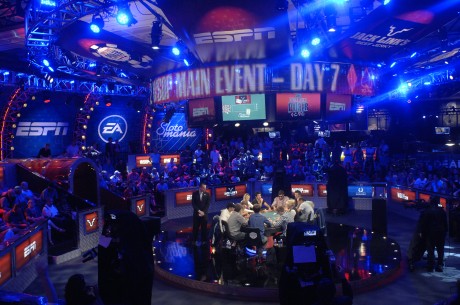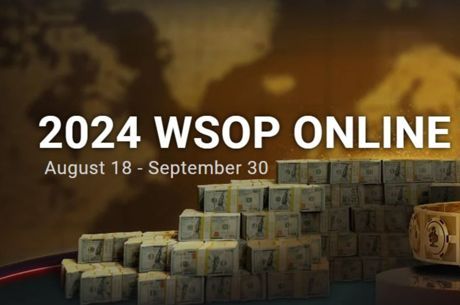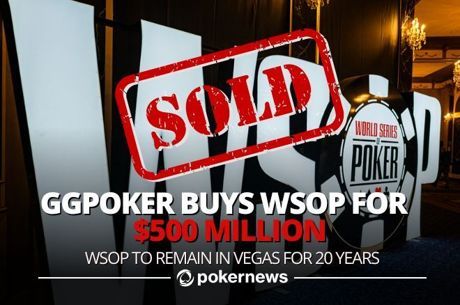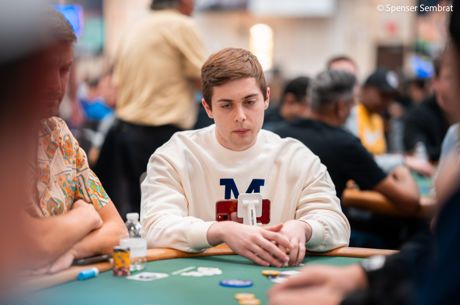$10 Million Up Top: Will the WSOP Guarantee "Work"?
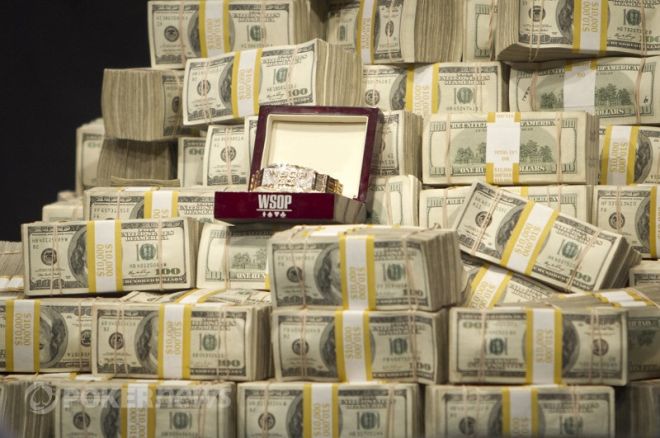
With few exceptions, every poker player��s dream is to win the Main Event of the World Series of Poker. This year, the WSOP has announced that this $10,000 buy-in marquee event will promise a guaranteed top prize of $10,000,000 for its champion. For some points of reference, the WSOP champion has not earned above $10,000,000 since 2006 when Jamie Gold won $12,000,000; in the years since then, the top prize has hovered around $8,000,000-$9,000,000 due to a decline in the number of players after 2006. Obviously, $10,000,000 is a lot of money, and it is remarkable that the WSOP can make this kind of promise. However, there is one question that has been floating around since this announcement: "Is this a good thing?"
The PokerNews Podcast crew discussed this in a recent episode on Feb. 20, 2014. Donnie Peters argued that it would be better to guarantee the entire prize pool rather than just the top prize, since most players who make the money will likely suffer a reduced payout under the current guarantee. This is because of the possibility that parts of the payouts from other spots will need to be shifted to the top prize in order to make the guarantee. Rich Ryan, on the other hand, argued in support of the top prize guarantee for marketing reasons, since it makes it more obvious to "Joe Six-Pack" what is possible for him to win, thus enticing him to play.
At first glance, this discussion appears to illustrate misaligned interests of the WSOP and its players. That is, players want the best payouts possible, and the WSOP wants to attract the most players possible. However, as Ty Stewart, WSOP Executive Director, stated on the podcast: if the WSOP is successful in its goal of attracting the most players possible, then this will in turn lead to great payouts.
So, if we can all agree that attracting more players is a good thing, then what is the best way to accomplish this? The reality is that a huge number of factors affect how many players will enter the WSOP Main Event in a given year. On the podcast, Peters alluded to this, stating that he thinks the number of players will increase this year regardless of any prize guarantee. Stewart dismissed this, saying that he cannot take that on faith and that he has an obligation to do something to ensure that the number of players will grow. To this end, the WSOP has chosen to implement a guarantee on the Main Event top prize because, as Stewart states, guarantees work.
But, do they? To answer this, it is important to be very clear on what is meant by the statement that "guarantees work." For instance, Stewart says that he would "bet the house" that, with the top prize guarantee as planned, everyone who cashes this year will end up winning more money than they would in the WSOP��s projected payouts without the top prize guarantee. The problem with this is that it is a completely unfair comparison, as Peters was trying to argue. According to Stewart, the WSOP��s projected payouts without the guarantee are based on a continuation of the recent decline in the number of players that has been observed over the past few years. Peters stated that there are reasons why the number of players will actually increase this year regardless of any prize guarantees, so to make a comparison based on an assumption that the number of players would continue to decline is essentially asking the wrong question.
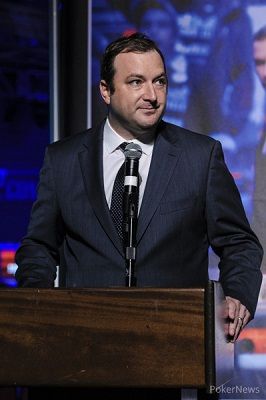
Statistically, what we are really trying to establish is known as a counterfactual argument. That is, when we have our payouts set for 2014 with the $10,000,000 guarantee, we��d like to compare that to the 2014 payouts that would have occurred with no guarantee. Obviously, we unfortunately will not actually get to observe what the 2014 payouts would be without the guarantee, so we cannot directly make this comparison.
The next best way to address this question is by running a huge experiment, in which tournaments are randomly assigned to have guarantees versus not have guarantees. Through this random assignment, you will end up with two comparable groups of tournaments. In many settings where the goal is to establish a causal link, this is exactly what is done (such as in clinical drug trials). However, it would be practically impossible here, because in order to do this, numerous poker rooms and tournament directors would need to be on board, and sacrifice control over their product for the sake of an experiment. Thus, I doubt that this been done.
Any other comparison between tournaments with guarantees and without guarantees is by definition merely observational, not experimental. And through an observational study, you can determine whether there is an association, but this does not imply causation. That is, even if tournaments with guarantees do tend to have larger prize pools, the question remains as to whether it is truly because of the guarantees, or because of other factors.
Now, I fully believe that the marketing team of the WSOP is well trained and very capable, given the product that we have observed over the past several years. There are in fact statistical methods to adjust for other factors that may be relevant to the question here, which I am sure they have employed. I am also in no way claiming to believe that guarantees do not work. I am simply having a hard time imagining a beautiful dataset that would give us a decent chance of answering this question properly. If the WSOP marketing team does have one, I would love to be proven wrong, in the name of good statistical practice.
There is one other issue though, even if it were somehow well established that guarantees do work in general. Let us turn our attention now to the fact that the 2014 WSOP Main Event has placed the guarantee only on the top prize. Through an extensive Google search, I have not been able to find any other poker tournament that has placed a guarantee only on the top prize, except for the "Millionaire Maker" from the 2013 WSOP. While the Millionaire Maker was widely regarded to be a huge success, the fact is that this gives us a sample size of n=1. As poker players, it should be fairly obvious to us that this is a problem. Furthermore, to draw conclusions with respect to the Main Event from this result is extremely dangerous because of two additional reasons: 1) the buy-in for the Millionaire Maker was much smaller (at $1500); 2) it was a re-entry tournament. To extrapolate from this to the $10,000 buy-in, single entry Main Event would be akin to concluding that if a cold medicine works on infants (or in particular, one infant who can keep coming back to life), then it should also work on an adult. Maybe, maybe not.
In my mind, the best data that could be collected to answer this question would be to poll each player from a number of tournaments with a guarantee on the top prize, and ask them if they would have played in it without the guarantee. While this would still be very imperfect (as any self-report survey has its issues), it gets at the question in the most direct way possible.
As a final note, Stewart mentions that this year, the WSOP is specifically targeting those whom they have called "dormants": the tens of thousands of players who have played exactly one Main Event in the last 10 years. I personally fall in this category, having played in the Main Event in 2006 when I won a seat on Full Tilt Poker. As I am specifically the type of player that Stewart is trying to entice into playing again, I will take the liberty of stating here what would get me to do so.
The first, and most important factor by a huge margin, is the ability to satellite online into the Main Event. Since Black Friday, this option has not been available to me, or anyone else like me. With the advent of legal and regulated online poker in the states of Nevada, New Jersey and Delaware, this is now a viable option for many players, specifically through WSOP.com. Unfortunately for me, I am not in one of those states.
The second factor is the return of Full Tilt Poker money. My balance was not huge in comparison to many others in my situation, but the four figures I had locked up will go a long way towards playing at my local casino and possibly running up the $10,000 buy-in, or playing in live satellites.
Now, to extrapolate from my statements would again have the sample size issue, since I am just one person. However, at least in this case, I believe that I am a decent representative of the overall population of dormants. Thus, I think Peters absolutely nailed it when he said that the number of players in the Main Event is going to increase this year because of satellites on WSOP.com and the return of FTP money. I would "bet the house" that both of these will have a much greater effect on the number of people playing this year than any guarantee, either on the top prize, the total prize pool, or otherwise.
Of course, this is just me. To know for sure, we��d have to ask all of the other dormants.
Peter Chi is an Assistant Professor of Statistics at California Polytechnic State University (Cal Poly) in San Luis Obispo, CA. While his professional interests lie mainly in biomedical research and genetics, he is an avid poker player and enjoys looking at applications of statistics to poker and gambling in general. He also enjoys teaching Probability Theory at Cal Poly by using numerous examples from poker and other games of chance. This is his first contribution to PokerNews.
Get all the latest PokerNews updates on your social media outlets. Follow us on Twitter and find us on both Facebook and Google+!


